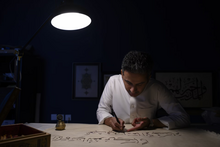| Part of a series on |
| Calligraphy |
|---|
 |


Arabic calligraphy is the artistic practice of handwriting and calligraphy based on the Arabic alphabet. It is known in Arabic as khatt (Arabic: خَطّ), derived from the words 'line', 'design', or 'construction'.[1][2] Kufic is the oldest form of the Arabic script.
From an artistic point of view, Arabic calligraphy has been known and appreciated for its diversity and great potential for development. In fact, it has been linked in Arabic culture to various fields such as religion, art, architecture, education and craftsmanship, which in turn have played an important role in its advancement.[3]
Although most Islamic calligraphy is in Arabic and most Arabic calligraphy is Islamic, the two are not identical. Coptic or other Christian manuscripts in Arabic, for example, have made use of calligraphy. Likewise, there is Islamic calligraphy in Persian and Ottoman Turkish.[4]
- ^ Julia Kaestle (10 July 2010). "Arabic calligraphy as a typographic exercise".
- ^ Stefan Widany (June 2011). The History of Arabic Calligraphy: An Essay on Its Greatest Artists and Its Development. GRIN Verlag. ISBN 978-3-640-93875-9.
- ^ Afā, ʻUmar.; افا، عمر. (2007). al-Khaṭṭ al-Maghribī : tārīkh wa-wāqiʻ wa-āfāq. Maghrāwī, Muḥammad., مغراوي، محمد. (al-Ṭabʻah 1 ed.). al-Dār al-Bayḍāʼ: Wizārat al-Awqāf wa-al-Shuʼūn al-Islāmīyah. ISBN 978-9981-59-129-5. OCLC 191880956.
- ^ "History - Persian Calligraphy- All about Persian Calligraphy". persiancalligraphy.org. Archived from the original on 2015-09-04. Retrieved 2021-03-17.